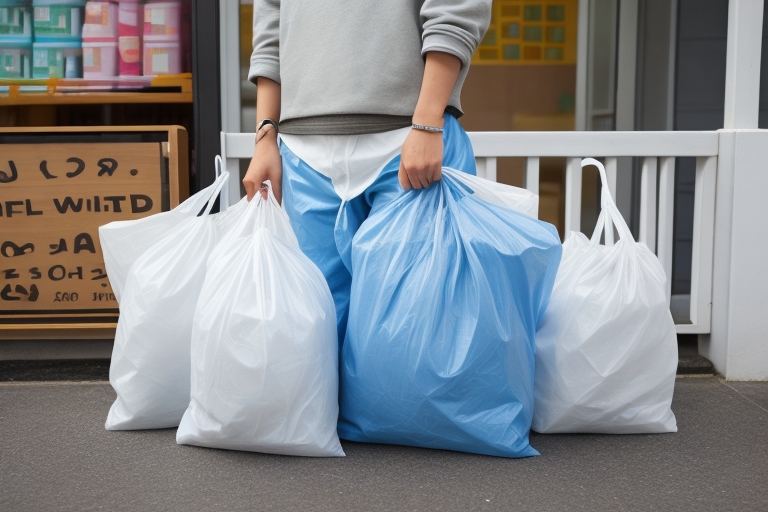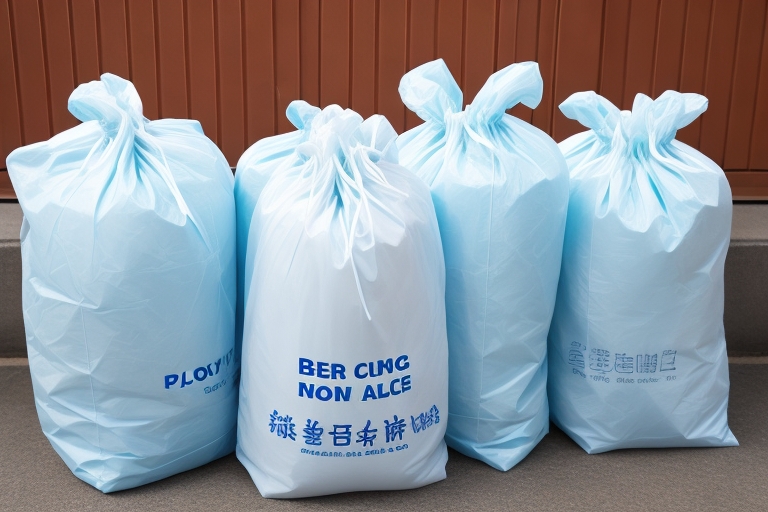
Plastic bags are not the safest option for food storage as they are not meant for long-term use and can release harmful chemicals into food, particularly when the food is fatty, acidic, or hot. To ensure the safety of your food, it is better to use containers made of food-grade materials like glass, stainless steel, or BPA-free plastic.
Plastic bags are not designed for long-term food storage because they can break down over time and release chemicals into the food. Some chemicals in the plastic can be harmful if consumed, especially when the food is hot, fatty, or acidic. These chemicals can cause health problems, including endocrine disruption, developmental and reproductive toxicity, and cancer. To avoid these risks, it is best to use food-grade containers made of materials that are safe for food storage and do not leach chemicals, such as glass, stainless steel, or BPA-free plastic.
In this article, we’ll explore both sides of the debate around plastic bags and food storage, as well as what potential health hazards are associated with them and what alternatives exist. Ultimately, we want to help you make an informed decision on whether plastic bags are right for you and your family.
Types of Plastic Bags
There are several types of plastic bags commonly used for food storage, each with its own characteristics and potential risks.
- Polyethylene (PE) Bags:
- Types: High-density polyethylene (HDPE) and low-density polyethylene (LDPE).
- Characteristics: PE bags are widely used and come in various thicknesses. HDPE bags are more rigid, while LDPE bags are more flexible.
- Risks: Generally considered safe for food storage, but may leach chemicals over time, especially when exposed to heat.
- Polypropylene (PP) Bags:
- Characteristics: PP bags are durable and resistant to wear and tear. They are often used for storing frozen food.
- Risks: Generally safe, but may release harmful chemicals when exposed to high temperatures.
- Polyvinyl Chloride (PVC) Bags:
- Characteristics: PVC bags are clear and have good flexibility.
- Risks: Contains harmful additives like phthalates and may release toxic chlorine gas when exposed to heat. Not recommended for microwaving.
- Polystyrene (PS) Bags:
- Characteristics: Lightweight and often used for packaging.
- Risks: Can leach styrene, a potential carcinogen, especially when in contact with hot or acidic foods.
- Polyethylene Terephthalate (PET) Bags:
- Characteristics: Transparent and commonly used for beverages and some food products.
- Risks: Generally considered safe, but may release antimony, a heavy metal, especially when exposed to heat.
When it comes to potential risks, the main concerns revolve around the release of chemicals from the plastic into the food, especially when exposed to heat or acidic conditions. It’s crucial to follow the recommended uses for each type of plastic and avoid microwaving or using them for hot foods if not specified as safe.
For a more eco-friendly option, consider reusable silicone or fabric bags, as they can be a safer alternative to traditional plastic bags.
What Are Plastic Bags Made Of?

Plastic bags are a common item found in almost every household, but are they safe for food storage? It’s important to understand the materials used to make plastic bags and their potential health hazards before making an informed decision.
Most plastic bags are made from polyethylene, which is a type of plastic polymer derived from petroleum or natural gas products. The polyethylene is melted down and then molded into thin sheets, which are cut and sealed into the shape of a bag. Depending on the thickness of the plastic, these bags can be used for single-use items like bread, snacks and frozen foods.
When heated up, plastic bags have the potential to leach toxic chemicals into food. These chemicals include bisphenol A (BPA) and phthalates, both of which can disrupt hormone levels and cause reproductive issues in humans. Furthermore, plastic bags also contain other potentially hazardous chemicals such as lead and cadmium that can be released when exposed to heat.
The pros of using plastic bags for food storage include convenience, cost-effectiveness, portability and lightweight nature. On the other hand, storing food in plastic bags could contaminate it with toxic chemicals if exposed to high temperatures or direct sunlight. Moreover, reusing plastic bags can increase the risk of bacterial contamination due to frequent handling and exposure to moisture from raw foods like fish or meat.
Before deciding whether or not to use plastic bags for food storage, it’s important to consider all possible alternatives including reusable containers made from glass or stainless steel with airtight lids that reduce the risk of contamination. Additionally, paper towels or waxed paper are better options for single-use items since they do not leach any hazardous substances into food when heated up.
It’s important to weigh both sides of the debate carefully before making an informed decision about storing food in plastic bags; understanding what materials are used in their production as well as their potential health hazards will help you make an educated decision that works best for your family’s needs.
Potential Risks of Plastic Bags
There are several potential risks associated with using plastic bags for food storage, both in terms of health and the environment.
1. Chemical Leaching:
- Bisphenol A (BPA): Found in some plastic bags, BPA is a known endocrine disruptor that may leach into food, especially when exposed to heat. It can mimic hormones in the body and potentially lead to health issues.
- Phthalates: Commonly found in plastic packaging, phthalates can leach into food and are associated with hormonal disruptions. They are often used to increase the flexibility and durability of plastics.
- Styrene: Present in polystyrene bags, it may leach into food, particularly when in contact with hot or acidic substances. Chronic exposure to styrene has been linked to health concerns.
2. Environmental Impact:
- Non-Biodegradability: Traditional plastic bags are made from petrochemicals and do not easily biodegrade. They can persist in the environment for hundreds of years, contributing to pollution.
- Microplastics: Over time, plastic bags break down into smaller particles called microplastics, which can contaminate soil, water, and even enter the food chain. Microplastics pose environmental and potential health risks.
- Wildlife Hazard: Animals, particularly marine life, can mistake plastic bags for food or become entangled in them. Ingesting or getting caught in plastic poses severe threats to wildlife.
3. Environmental Pollution:
- Air Pollution: The production and incineration of plastic bags release harmful pollutants into the air, contributing to air pollution and climate change.
- Water Pollution: Improper disposal of plastic bags can lead to water pollution. They may clog waterways, affecting aquatic ecosystems, and the breakdown of plastics releases toxins into the water.
4. Recycling Challenges:
- Limited Recycling: Not all plastic bags are easily recyclable, and the recycling process can be complex. Many end up in landfills, exacerbating the waste problem.
To mitigate these risks, consider using reusable and eco-friendly alternatives, such as cloth bags, silicone bags, or containers made from safer materials. Additionally, proper disposal through recycling programs and reducing overall plastic consumption can contribute to a healthier environment.
Alternatives to Plastic Bags
There are several alternatives to traditional plastic bags for food storage, each with its own set of benefits and reduced potential risks.
- Reusable Cloth Bags:
- Benefits: Cloth bags, often made from materials like cotton or canvas, are durable and can be washed and reused multiple times. They come in various sizes and are suitable for a wide range of food items.
- Reduced Risks: Cloth bags do not leach harmful chemicals into food, reducing the risk of chemical exposure. They are also environmentally friendly and contribute to a reduction in single-use plastic waste.
- Silicone Bags:
- Benefits: Silicone bags are a flexible and heat-resistant alternative to plastic. They are reusable, airtight, and suitable for freezing, microwaving, and sous vide cooking.
- Reduced Risks: Silicone is generally considered safe for food storage, and silicone bags are durable, reducing the need for single-use plastic bags. They also lack the harmful chemicals found in some plastics.
- Glass Containers:
- Benefits: Glass containers are a sturdy and non-toxic option for food storage. They are versatile, allowing for easy reheating in the microwave or oven.
- Reduced Risks: Glass does not leach harmful substances into food, providing a safer alternative to plastic. Glass containers are also durable and can be reused for an extended period.
- Stainless Steel Containers:
- Benefits: Stainless steel containers are durable, lightweight, and resistant to rust and corrosion. They are suitable for both storing and transporting food.
- Reduced Risks: Stainless steel is inert and does not react with food, eliminating the risk of chemical leaching. Stainless steel containers are a long-lasting and eco-friendly choice.
- Beeswax Wraps:
- Benefits: Beeswax wraps are a sustainable alternative to plastic wrap for covering and preserving food. They are reusable and can be easily cleaned.
- Reduced Risks: Beeswax wraps are made from natural materials and do not pose the same environmental and health risks as plastic wrap. They are biodegradable and contribute to a reduction in plastic waste.
- Paper Bags:
- Benefits: Paper bags are a biodegradable and recyclable option for short-term food storage. They are often used for items like bread, fruits, and vegetables.
- Reduced Risks: Paper bags have minimal environmental impact and can be recycled or composted. While not suitable for all food storage needs, they offer a more sustainable option for certain items.
By choosing these alternatives, individuals can reduce their reliance on single-use plastics, decrease the environmental impact of packaging waste, and minimize potential health risks associated with plastic leaching. Reusable options, in particular, contribute to a more sustainable and eco-friendly approach to food storage.
FAQs
- Can I use any plastic bag for food storage?
- Not all plastic bags are created equal. Look for bags labeled as “food-grade” or “safe for food storage” to ensure they meet safety standards.
- Are Ziploc bags safe for storing food?
- Yes, most Ziploc bags are designed for food storage and are made from materials deemed safe for storing a variety of foods.
- Can I microwave food in plastic bags?
- It’s essential to check the bag’s label. Some plastic bags are microwave-safe, but others may release harmful substances when heated. Opt for bags explicitly labeled as microwave-safe.
- Are plastic bags safe for storing hot liquids?
- It’s generally not recommended to store hot liquids in plastic bags, as heat can cause certain chemicals to leach into the food. Use containers designed for hot liquids instead.
- How long can I store food in plastic bags?
- Check the expiration date on the plastic bags, and follow any guidelines provided by the manufacturer. Additionally, avoid storing food for extended periods, as the quality may deteriorate over time.

Pingback: How long can food be stored in vacuum-sealed bags? - Food Storage